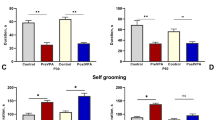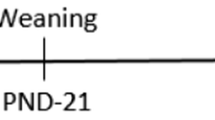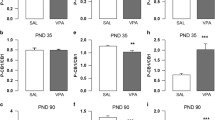Abstract
Autism spectrum disorder (ASD) is a neurodevelopmental condition that is characterized by difficulty in social behavior and restricted behaviors. Also, in ASD, several accompanying disorders such as anxiety are observed. Considering the important role of amygdala in the pathophysiology of ASD, the present study focused on the neuronal changes and it possible signaling pathway in amygdala. After prenatal exposure to valproate (VPA; 600 mg/kg, i.p, on embryonic day 12.5), amount of ROS, MMP, caspase-3 activity, AMPK, SIRT1 and PGC1α proteins, and parvalbumin interneurons in the amygdala were assessed following evaluation of ASD and anxiety-like behaviors. Amygdala analysis revealed ROS accumulation and decreased MMP in autistic rats. In addition, caspase-3 activation elevated and immunoreactivity for parvalbumin interneurons decreased. These were accompanied by anxiety and autistic-like behaviors in open field test, elevated zero maze and U-Shaped 2 Choice Field maze. Also, our data showed that in the valproate group, protein levels of AMPK, SIRT1 and PGC1α reduced. Collectively, our results indicate that prenatal exposure to valproate leads to anxiety and autistic-like behaviors, partly through its targeting amygdala parvalbumin interneurons dysfunction and this might be affected by disturbed AMPK/SIRT1/PGC1α signaling pathway.
Graphical Abstract






Similar content being viewed by others
Data Availability
Data of this study will be available from the corresponding author on reasonable request.
Code Availability
Not applicable.
Abbreviations
- AMPK:
-
Adenosine monophosphate-activated protein kinase
- ASD:
-
Autism spectrum disorder
- BLA:
-
Basolateral amygdala
- CAT:
-
Catalase
- Casp3:
-
Caspase-3
- Gpx:
-
Glutathione Peroxidase
- MMP:
-
Mitochondrial membrane potential
- PGC1α:
-
Peroxisome proliferator-activated receptor-gamma coactivator 1 alpha
- PV:
-
Parvalbumin
- PVI:
-
Parvalbumin-positive interneuron
- ROS:
-
Reactive oxygen species
- SIRT1:
-
Sirtuin 1
- SOD:
-
Superoxide dismutase
- VPA:
-
Valproate
References
Al Sagheer T, Haida O, Balbous A, Francheteau M, Matas E, Fernagut PO, Jaber M (2018) Motor impairments correlate with Social Deficits and restricted neuronal loss in an environmental model of Autism. Int J Neuropsychopharmacol 21:871–882. https://doi.org/10.1093/ijnp/pyy043
Al-Askar M, Bhat RS, Selim M, Al-Ayadhi L, El-Ansary A (2017) Postnatal treatment using curcumin supplements to amend the damage in VPA-induced rodent models of autism. BMC Complement Altern Med 17:259. https://doi.org/10.1186/s12906-017-1763-7
Al-Gubory KH, Fowler PA, Garrel C (2010) The roles of cellular reactive oxygen species, oxidative stress and antioxidants in pregnancy outcomes. Int J Biochem Cell Biol 42:1634–1650. https://doi.org/10.1016/j.biocel.2010.06.001
Association AP (2013) Diagnostic and statistical manual of mental disorders. American Psychiatric Publishing
Babaei H, Alibabrdel M, Asadian S, Siavashi V, Jabarpour M, Nassiri SM (2018) Increased circulation mobilization of endothelial progenitor cells in preterm infants with retinopathy of prematurity. J Cell Biochem 119:6575–6583. https://doi.org/10.1002/jcb.26777
Baracca A, Sgarbi G, Solaini G, Lenaz G (2003) Rhodamine 123 as a probe of mitochondrial membrane potential: evaluation of proton flux through F(0) during ATP synthesis. Biochim Biophys Acta 1606:137–146. https://doi.org/10.1016/s0005-2728(03)00110-5
Bauman M, Kemper TL (1985) Histoanatomic observations of the brain in early infantile autism. Neurology 35:866–874. https://doi.org/10.1212/wnl.35.6.866
Cantó C, Gerhart-Hines Z, Feige JN, Lagouge M, Noriega L, Milne JC, Elliott PJ, Puigserver P, Auwerx J (2009) AMPK regulates energy expenditure by modulating NAD + metabolism and SIRT1 activity. Nature 458:1056–1060. https://doi.org/10.1038/nature07813
Christensen J, Grønborg TK, Sørensen MJ, Schendel D, Parner ET, Pedersen LH, Vestergaard M (2013) Prenatal valproate exposure and risk of autism spectrum disorders and childhood autism. JAMA 309:1696–1703. https://doi.org/10.1001/jama.2013.2270
Christoforou A, McGhee K, Morris S, Thomson P, Anderson S, McLean A, Torrance H, Le Hellard S, Pickard B, StClair DJMp (2011) Convergence of linkage, association and GWAS findings for a candidate region for bipolar disorder and schizophrenia on chromosome 4. 16:240–242
Cowell RM, Blake KR, Russell JWJJoCN (2007) Localization of the transcriptional coactivator PGC-1α to GABAergic neurons during maturation of the rat brain. 502:1–18
Cowell RM, Talati P, Blake KR, Meador-Woodruff JH, Russell JWJB (2009) communications br Identification of novel targets for PGC-1α and histone deacetylase inhibitors in neuroblastoma cells. 379: 578–582
Culmsee C, Monnig J, Kemp BE, Mattson MP (2001) AMP-activated protein kinase is highly expressed in neurons in the developing rat brain and promotes neuronal survival following glucose deprivation. J Mol Neurosci 17:45–58. https://doi.org/10.1385/jmn:17:1:45
Cunningham JT, Rodgers JT, Arlow DH, Vazquez F, Mootha VK, Puigserver PJn (2007) mTOR controls mitochondrial oxidative function through a YY1–PGC-1α transcriptional complex. 450:736–740
Deckmann I, Schwingel GB, Fontes-Dutra M, Bambini-Junior V, Gottfried C (2018) Neuroimmune alterations in Autism: a translational analysis focusing on the animal model of Autism Induced by prenatal exposure to Valproic Acid. Neuroimmunomodulation 25:285–299. https://doi.org/10.1159/000492113
Felix-Ortiz AC, Burgos-Robles A, Bhagat ND, Leppla CA, Tye KMJN (2016) Bidirectional modulation of anxiety-related and social behaviors by amygdala projections to the medial prefrontal cortex. 321:197–209
Gandal MJ, Nesbitt AM, McCurdy RM, Alter MD (2012) Measuring the maturity of the fast-spiking interneuron transcriptional program in autism, schizophrenia, and bipolar disorder. PLoS ONE 7:e41215. https://doi.org/10.1371/journal.pone.0041215
Gogolla N, Leblanc JJ, Quast KB, Südhof TC, Fagiolini M, Hensch TK (2009) Common circuit defect of excitatory-inhibitory balance in mouse models of autism. J Neurodev Disord 1:172–181. https://doi.org/10.1007/s11689-009-9023-x
Hennessy A, Seguin D, Correa S, Wang J, Martinez-Trujillo JC, Nicolson R, Duerden EG (2022) Anxiety in children and youth with autism spectrum disorder and the association with amygdala subnuclei structure. Autism: 13623613221127512. doi:https://doi.org/10.1177/13623613221127512
Herrington JD, Maddox BB, Kerns CM, Rump K, Worley JA, Bush JC, McVey AJ, Schultz RT, Miller JS (2017) Amygdala volume differences in Autism Spectrum Disorder are related to anxiety. J Autism Dev Disord 47:3682–3691. https://doi.org/10.1007/s10803-017-3206-1
Kann O, Papageorgiou IE, Draguhn A (2014) Highly energized inhibitory interneurons are a central element for information processing in cortical networks. J Cereb Blood Flow Metab 34:1270–1282. https://doi.org/10.1038/jcbfm.2014.104
Kataoka S, Takuma K, Hara Y, Maeda Y, Ago Y, Matsuda T (2013) Autism-like behaviours with transient histone hyperacetylation in mice treated prenatally with valproic acid. Int J Neuropsychopharmacol 16:91–103. https://doi.org/10.1017/s1461145711001714
Keshavarz-Bahaghighat H, Sepand MR, Ghahremani MH, Aghsami M, Sanadgol N, Omidi A, Bodaghi-Namileh V, Sabzevari O (2018) Acetyl-L-Carnitine attenuates Arsenic-Induced oxidative stress and hippocampal mitochondrial dysfunction. Biol Trace Elem Res 184:422–435. https://doi.org/10.1007/s12011-017-1210-0
Kim KC, Lee DK, Go HS, Kim P, Choi CS, Kim JW, Jeon SJ, Song MR, Shin CY (2014) Pax6-dependent cortical glutamatergic neuronal differentiation regulates autism-like behavior in prenatally valproic acid-exposed rat offspring. Mol Neurobiol 49:512–528. https://doi.org/10.1007/s12035-013-8535-2
Ko J, Choii G, Um JW (2015) The balancing act of GABAergic synapse organizers. Trends Mol Med 21:256–268. https://doi.org/10.1016/j.molmed.2015.01.004
Lee JH, Koh H, Kim M, Kim Y, Lee SY, Karess RE, Lee SH, Shong M, Kim JM, Kim J, Chung J (2007) Energy-dependent regulation of cell structure by AMP-activated protein kinase. Nature 447:1017–1020. https://doi.org/10.1038/nature05828
Lee Y-A, Obora T, Bondonny L, Toniolo A, Mivielle J, Yamaguchi Y, Kato A, Takita M, Goto YJSr (2018) The effects of housing density on social interactions and their correlations with serotonin in rodents and primates. 8: 3497
Li Q, Zhou JM (2016) The microbiota-gut-brain axis and its potential therapeutic role in autism spectrum disorder. Neuroscience 324:131–139. https://doi.org/10.1016/j.neuroscience.2016.03.013
Li G, Chen MH, Li G, Wu D, Lian C, Sun Q, Shen D, Wang L (2019) A Longitudinal MRI Study of Amygdala and Hippocampal Subfields for Infants with Risk of Autism. Graph Learn Med Imaging (2019) 11849: 164–171. doi:https://doi.org/10.1007/978-3-030-35817-4_20
Lord C, Elsabbagh M, Baird G, Veenstra-Vanderweele J (2018) Autism spectrum disorder. Lancet 392:508–520. https://doi.org/10.1016/s0140-6736(18)31129-2
Lord C, Brugha TS, Charman T, Cusack J, Dumas G, Frazier T, Jones EJH, Jones RM, Pickles A, State MW, Taylor JL, Veenstra-VanderWeele J (2020) Autism spectrum disorder. Nat Rev Dis Primers 6:5. https://doi.org/10.1038/s41572-019-0138-4
Marín O (2012) Interneuron dysfunction in psychiatric disorders. Nat Rev Neurosci 13:107–120. https://doi.org/10.1038/nrn3155
Mizuno Y, Kagitani-Shimono K, Jung M, Makita K, Takiguchi S, Fujisawa TX, Tachibana M, Nakanishi M, Mohri I, Taniike M, Tomoda A (2019) Structural brain abnormalities in children and adolescents with comorbid autism spectrum disorder and attention-deficit/hyperactivity disorder. Transl Psychiatry 9:332. https://doi.org/10.1038/s41398-019-0679-z
Muraleedharan R, Dasgupta B (2022) AMPK in the brain: its roles in glucose and neural metabolism. Febs j 289:2247–2262. https://doi.org/10.1111/febs.16151
Nicolini C, Fahnestock M (2018) The valproic acid-induced rodent model of autism. Exp Neurol 299:217–227. https://doi.org/10.1016/j.expneurol.2017.04.017
Nicolini C, Ahn Y, Michalski B, Rho JM, Fahnestock M (2015) Decreased mTOR signaling pathway in human idiopathic autism and in rats exposed to valproic acid. Acta Neuropathol Commun 3:3. https://doi.org/10.1186/s40478-015-0184-4
Ogawa T, Kuwagata M, Hori Y, Shioda S (2007) Valproate-induced developmental neurotoxicity is affected by maternal conditions including shipping stress and environmental change during early pregnancy. Toxicol Lett 174:18–24. https://doi.org/10.1016/j.toxlet.2007.08.006
Ornoy A, Weinstein-Fudim L, Ergaz Z (2015) Prenatal factors associated with autism spectrum disorder (ASD). Reprod Toxicol 56:155–169. https://doi.org/10.1016/j.reprotox.2015.05.007
Qiu J, Guo H, Li L, Xu Z, Xu Z, Jing X, Hu Y, Wen X, Chen F, Lu X (2020) Valproic acid therapy decreases serum 25-hydroxyvitamin D level in female infants and toddlers with epilepsy- a pilot longitudinal study. J Biomed Res 35:61–67. https://doi.org/10.7555/jbr.34.20200057
Ruden JB, Dugan LL, Konradi C (2021a) Parvalbumin interneuron vulnerability and brain disorders. Neuropsychopharmacology 46:279–287. https://doi.org/10.1038/s41386-020-0778-9
Ruden JB, Dugan LL, Konradi CJN (2021b) Parvalbumin interneuron vulnerability and brain disorders. 46:279–287
Rudolph U, Möhler H (2014) GABAA receptor subtypes: therapeutic potential in Down syndrome, affective disorders, schizophrenia, and autism. Annu Rev Pharmacol Toxicol 54:483–507. https://doi.org/10.1146/annurev-pharmtox-011613-135947
Ruggieri VL (2014) [The amygdala and its relation to autism, behavioural disorders and other neurodevelopmental disorders]. Rev Neurol 58(Suppl 1):S137–148
Sah P, Faber ES, Lopez De Armentia M, Power J (2003) The amygdaloid complex: anatomy and physiology. Physiol Rev 83:803–834. https://doi.org/10.1152/physrev.00002.2003
Saré RM, Lemons A, Smith CB (2021) Behavior testing in rodents: highlighting potential Confounds affecting variability and reproducibility. Brain Sci 11. https://doi.org/10.3390/brainsci11040522
Schneider T, Roman A, Basta-Kaim A, Kubera M, Budziszewska B, Schneider K, Przewłocki R (2008a) Gender-specific behavioral and immunological alterations in an animal model of autism induced by prenatal exposure to valproic acid. Psychoneuroendocrinology 33:728–740. https://doi.org/10.1016/j.psyneuen.2008.02.011
Schneider T, Roman A, Basta-Kaim A, Kubera M, Budziszewska B, Schneider K, Przewłocki RJP (2008b) Gender-specific behavioral and immunological alterations in an animal model of autism induced by prenatal exposure to valproic acid. 33:728–740
Seguin D, Pac S, Wang J, Nicolson R, Martinez-Trujillo J, Duerden EGJB, Behavior (2021) Amygdala subnuclei development in adolescents with autism spectrum disorder: Association with social communication and repetitive behaviors. 11:e2299
Taleb A, Ahmad KA, Ihsan AU, Qu J, Lin N, Hezam K, Koju N, Hui L, Qilong D (2018) Antioxidant effects and mechanism of silymarin in oxidative stress induced cardiovascular diseases. Biomed Pharmacother 102:689–698. https://doi.org/10.1016/j.biopha.2018.03.140
Taleb A, Lin W, Xu X, Zhang G, Zhou Q-G, Naveed M, Meng F, Fukunaga K, Han F (2021) Emerging mechanisms of valproic acid-induced neurotoxic events in autism and its implications for pharmacological treatment. Biomed Pharmacother 137:111322
Truitt WA, Sajdyk TJ, Dietrich AD, Oberlin B, McDougle CJ, Shekhar A (2007a) From anxiety to autism: spectrum of abnormal social behaviors modeled by progressive disruption of inhibitory neuronal function in the basolateral amygdala in Wistar rats. Psychopharmacology 191:107–118. https://doi.org/10.1007/s00213-006-0674-y
Truitt WA, Sajdyk TJ, Dietrich AD, Oberlin B, McDougle CJ, Shekhar AJP (2007b) From anxiety to autism: spectrum of abnormal social behaviors modeled by progressive disruption of inhibitory neuronal function in the basolateral amygdala in Wistar rats. 191:107–118
Tung EW, Winn LM (2011) Valproic acid increases formation of reactive oxygen species and induces apoptosis in postimplantation embryos: a role for oxidative stress in valproic acid-induced neural tube defects. Mol Pharmacol 80:979–987. https://doi.org/10.1124/mol.111.072314
Whittaker RG, Turnbull DM, Whittington MA, Cunningham MO (2011) Impaired mitochondrial function abolishes gamma oscillations in the hippocampus through an effect on fast-spiking interneurons. Brain 134 e180; author reply e181. https://doi.org/10.1093/brain/awr018
Wood AG, Nadebaum C, Anderson V, Reutens D, Barton S, O’Brien TJ, Vajda F (2015) Prospective assessment of autism traits in children exposed to antiepileptic drugs during pregnancy. Epilepsia 56:1047–1055. https://doi.org/10.1111/epi.13007
Zalla T, Sperduti M (2013) The amygdala and the relevance detection theory of autism: an evolutionary perspective. Front Hum Neurosci 7:894. https://doi.org/10.3389/fnhum.2013.00894
Funding
This research study was certified and financially supported (grant # 49200) by Tehran University of Medical Science (Tehran, Iran).
Author information
Authors and Affiliations
Contributions
SSS and MR conceived and designed the study. EZ and AS conducted experiments, analyzed data and wrote the initial manuscript. All authors contributed equally for finalizing the manuscript.
Corresponding authors
Ethics declarations
Ethics approval
This study was approved by Ethics Committee of Tehran University of Medical Sciences (IR.TUMS.MEDICINE.REC.1400.564).
Consent for publication
All authors approved the submitted manuscript.
Consent to participate
Not applicable.
Conflict of interest
The authors declare no competing interests.
Additional information
Publisher’s Note
Springer Nature remains neutral with regard to jurisdictional claims in published maps and institutional affiliations.
Rights and permissions
Springer Nature or its licensor (e.g. a society or other partner) holds exclusive rights to this article under a publishing agreement with the author(s) or other rightsholder(s); author self-archiving of the accepted manuscript version of this article is solely governed by the terms of such publishing agreement and applicable law.
About this article
Cite this article
Zahedi, E., Sadr, S.S., Sanaeierad, A. et al. Valproate-induced murine autism spectrum disorder is associated with dysfunction of amygdala parvalbumin interneurons and downregulation of AMPK/SIRT1/PGC1α signaling. Metab Brain Dis 38, 2093–2103 (2023). https://doi.org/10.1007/s11011-023-01227-1
Received:
Accepted:
Published:
Issue Date:
DOI: https://doi.org/10.1007/s11011-023-01227-1




